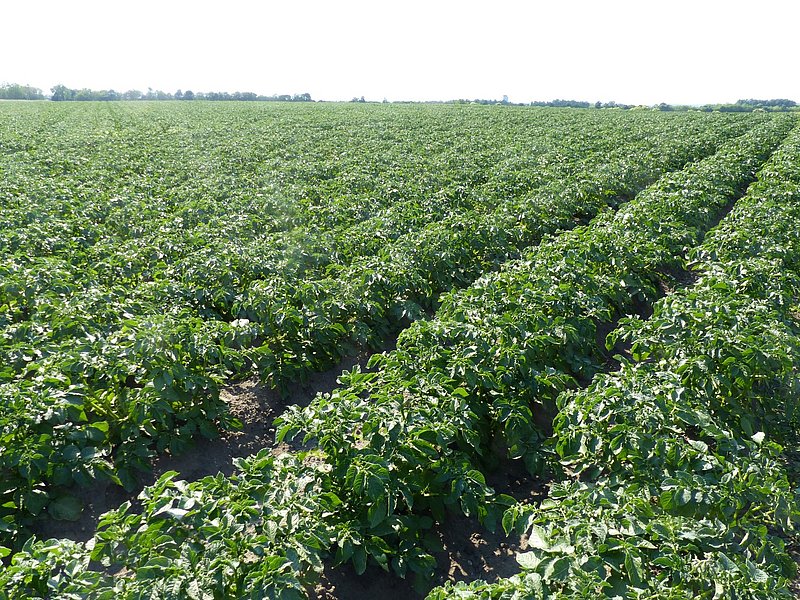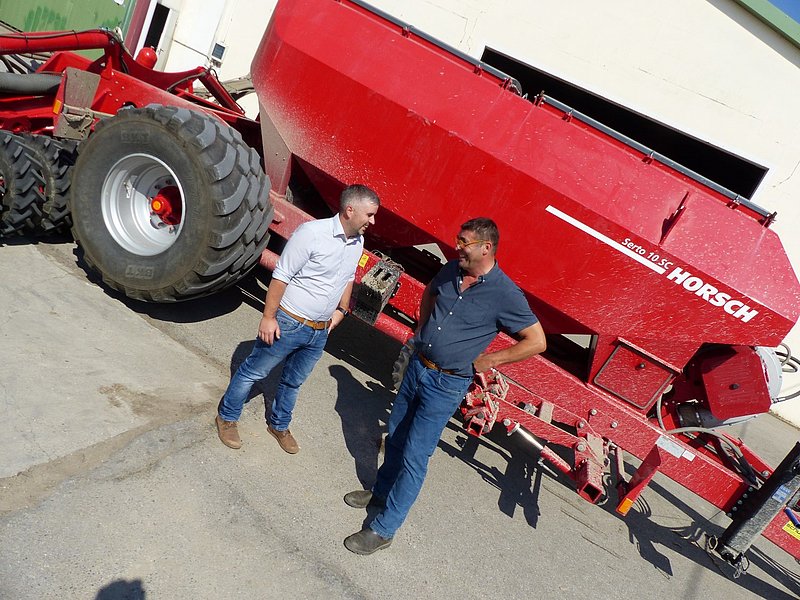Landscape designer
A large, modern agricultural farm and intact nature are no opposites – and Gut Hardegg located in the Weinviertel in Austria is an impressive proof of this statement. terraHORSCH took a look around the estate.
Already from a distance you can see a high silo tower in the valley of the Pulkau (northern Weinviertel, Lower Austria). Regarding its size it would actually be more in line with an agri-trade company or a co-operative. But it is part of Gut Hardegg, an agricultural farm that has been owned by the Hardegg family for more than ten generations. We have an appointment with Maximilian Hardegg and Christoph Hoß, the manager of the agricultural part of the farm. Maximilian Hardegg is quite well-known. He studied agricultural sciences at the TU Munich. He then worked in the economic sector and since 1995 he has been managing the family estate. He is a committed representative of his profession. Among others he was a member of the management board of the DLG (German Agricultural Society) as well as of the lobby of landowners on a European level.

“2022 is a turning point – a year of disruption“, Maximilian Hardegg is convinced. “The war in the Ukraine questions our world order. It relentlessly uncovers the weaknesses and dependencies of our economic system – especially with regard to food. Already before the war, the world markets have been very tense regarding a lot of agricultural products. At the same time the fertiliser prices increased rapidly. Transport bottlenecks and cost increases exerted an immense pressure on the markets. All this led to insecurity among the farmers – the more so as the factors weather and climate, especially the risk of droughts, are also an important issue. Given that 30% of the worldwide quantity of wheat comes from Russia and the Ukraine alone and that there is the risk that this quantity will not be available at all, it is not clear at which scale the world market prices are going to develop. This is why I fear that there soon will be new trouble spots in Africa and the Middle East. Now we farmers can prove that we are able to influence the situation in a positive way. We can make our production more efficient, handle resources more carefully, rely more on rotation and recycling management and thus increase the yields. But we still have to pay attention to nature and biodiversity.“
Crops at Gut Hardegg
Crop | Area (ha) | Share (%) | Average yield (kg/ha) |
Winter wheat | 713 | 33 | 7,000 |
Winter barley | 241 | 11 | 8,500 |
Spelt, durum, rye | 79 | 4 | 6,000 |
Spring oats | 21 | 1 | 5,000 |
|
|
|
|
Grain maize | 346 | 16 | 11,500 |
Sugar beet | 64 | 3 | 100,000 |
Potato | 100 | 5 | 55,000 |
Soya | 78 | 4 | 3,500 |
|
|
|
|
Winter rape | 159 | 7 | 3,800 |
Grain pea | 35 | 2 | 4,000 |
Sunflower | 125 | 6 | 3,800 |
|
|
|
|
Biodiversity fields | 171 | 8 | - |
Fallow land | 61 | 3 | - |
Source: Gut Hardegg, values rounded
Water is scarce
Gut Hardegg is divided into four branches:
- Agriculture / arable farming
- Forestry / hunt / landscape management
- Animal husbandry: pig breeding
- Viticulture (organic)
The area of holding amounts to well over 2,200 ha, 40 ha of it is renaturation land and 180 ha is biodiversity land. Moreover, there are 650 ha of forests and copse. Wine is grown on about 30 ha. A second part of the farm with about 400 ha is located south of Prague in the Czech Republic. Previously, it was run separately from there and by a third party but today the farm is managed from Austria. There is a basic mechanisation for tillage on site in the Czech Republic, for the remaining tasks the machines come from Austria. “It takes us about 5 h to go there with a tractor. Most passes can be carried out during two long working days”, Christoph Hoß explains. “We have assigned one employee to deal with these fields.”

For two years, Christoph Hoß has been managing the agricultural farm at Gut Hardegg. Before he worked on several other large farms in Central and Eastern Europe. The requirement of his boss is clear: combine modern, state-of-the-art agriculture with environmental issues. This is why currently a lot of things are reorganised. One example is the use of the offset method when sowing. “There are two reasons“, the farm manager explains. “As we encourage the formation of capillaries for the autumn crops, we save water. In our continental climate, drought already is a big problem, but it will become even more important in the future. Already now we are irrigating about 1,000 ha of our land. It is a targeted measure in yield-reducing conditions to help to cope with this stress moment to prevent a premature maturation. The second reason is a work process-efficient one. Already in August, we can prepare the fields for sowing. And if tillage has already been completed previously, two employees can sow stress free with the HORSCH Serto. In addition, with a working width of 10 m we were thus able to increase the hectare output to 200 ha per day. And: The placement quality is better, too. Initial problems with regard to SectionControl and coulter pressure were solved quickly. Now the performance is excellent!
The sowing density always is a matter of conviction. There are different opinions that range from 150 to 350 grains per m2. I prefer a compact population right from the start that in spring already provides a certain protection. For the less plants there are per m2 the less they are able to protect each other. We are just carrying out internal tests to confirm this assumption.“

New sprayer
Logistics is another important topic. Huge quantities are moved not only during the harvest but also for fertilisation and crop care measures. “We are thinking about the introduction of a Shuttle system”, Christoph Hoß says. “The auger wagon, but especially the crop care sprayer and also the liquid manure tanker as a transport vehicle do not belong on the road. For us, there will be a change in the plant protection sector for we are just waiting for the delivery of a self-propelled sprayer HORSCH Leeb 6.300 VN and a HORSCH Shuttle 8 000 L. This is an important investment as plant protection is one of our core competences. The plan is to have the sprayer work in two shifts from 4 a.m. to 9 p.m. It would then be used to its full capacity. The team, of course, has to co-operate well. The objective is 240 ha per day. With regard to our varied crops, I attach major importance to a good cleaning system. For it may be that the sprayer has to leave the maize to go into potatoes at short notice. Moreover, we work with AHL and, of course, the HORSCH Leeb will be used for this, too.“
Some facts about the pig breeding branch of Gut Hardegg. Though it is not managed by Christoph Hoß, he still is an important interface. For 1/3 of the yields achieved by 300 ha of barley and 350 ha of maize are required to feed the pigs, among them 1,100 sows. The farm is a recognised breeding company and raises approx. 25,000 fattening piglets which partly are fed until slaughtering in the 6,500 own fattening places. “Pig breeding perfectly fits our farm. And I am particularly proud of the fact that already 20 years ago, we started to rely on a species-appropriate keeping of the sows in groups”, Maximilian Hardegg says. “The cultivation of the fields and viticulture benefit enormously from the organic fertilising effect. In the field we also use separated liquid manure, but the best effect is achieved by incorporating it directly into the soil. For our viticulture branch we use straw and liquid manure to produce a high-quality compost which is ideal to encourage the formation of humus. In addition, pig keeping increases the added value to the whole farm by some per cent.”

Farm statistics Gut Hardegg
Farming: 2,200 ha
Viticulture: 30 ha
Forestry: 640 ha
Staff farming: 5 workers, 2 employees (total: 40)
Tractive power: 68 kW (93 hp)/100 ha
Harvest power: 34 kW (46 hp)/100 ha
Rainfall annual average: 480 mm
Rainfall vegetation period: 300 mm (62.5%)
Sunshine duration: 1,870 h/a
Temperatures annual average: 10.0 °C (extremes: -25 to +35 °C)
Lived variety of species
The motto of the agricultural production at Gut Hardegg that Maximilian Hardegg and his employees fixed together is: lived variety of species. “A sustainable agriculture needs field and singing birds, insects, small game and especially vital soils”, the agricultural engineer emphasizes. “And we do a lot in this respect. We work according to the 4-column model we developed.”
It consists of:
- Wildlife-friendly agriculture
- All-year feeding
- Valuable habitats
- Care of the habitat (by professional hunters)
“This is neither difficult nor expensive“, Maximilian Hardegg explains. “It is rather a question of attitude, awareness and the own access to nature. Wildlife-friendly agriculture is considerate of the interests of the animals. The valuable habitats include field boundary and wildflower strips, specifically created water holes, old river arms, copse and beetle banks. They have to be cared for by hunters. For this regulation guarantees a balance. We need all-year feeding because with modern farming only little harvest residues remain on the field. Each of these columns makes a difference. We often have to find compromises, but success comes from this combination.”

A tour on the farm shows a rare image: From an agronomic point of view everything is immaculate. The populations look good and are regular. But there still is enough room for nature. And the most important point is: there are no solitary “token measures”. The biotops are linked with each other what due to the farm size even increases the effect. The hunter is happy about the high pheasant population that is not due to the release of the animals into the natural environment – the population is completely natural. Maximilian Hardegg is even more proud of the singing birds: “Some time ago, we counted more than 70 different species in three days. This is an incorruptible proof that our concept works. At the moment we are working on a scientific project about the turtle dove (Streptopelia turtur). It is the “patron” of a lot of other bird species. During the past 20 to 30 years the populations especially in Germany, Austria and Great Britain decreased dramatically: a decrease of 90%. In Austria, there only are 10,000 breeding pairs. 200 of them can be found at Gut Hardegg. And we are very proud of this. Thus, we can actively contribute to wildlife conservation. The next project will be to implant transmitters to the animals to accompany them on their way to the south.”
With all these efforts: Why not organic farming? Maximilian Hardegg’s opinion is clear: “Our farm is to contribute to feeding people. This is why we do not want to forego yields. Moreover, I as a farmer enjoy making the best of our scarce resources, especially with regard to rainfall. Organic farming does not provide any advantage for the work we do, not even in the market. Our value proposition is biodiversity. In my opinion, this clearly stands above the question “organic – not organic”. And biodiversity is clearly visible on the Gut Hardegg products. We are well established for example due to several wines and flour varieties as well as the honey from our own bee colonies. There still is potential for Gut Hardegg as society’s demand for an intact nature constantly grows.”